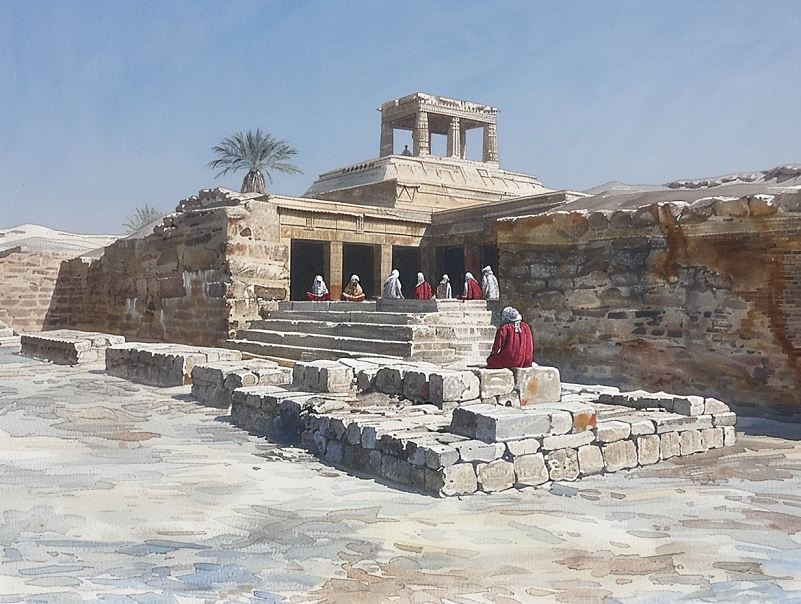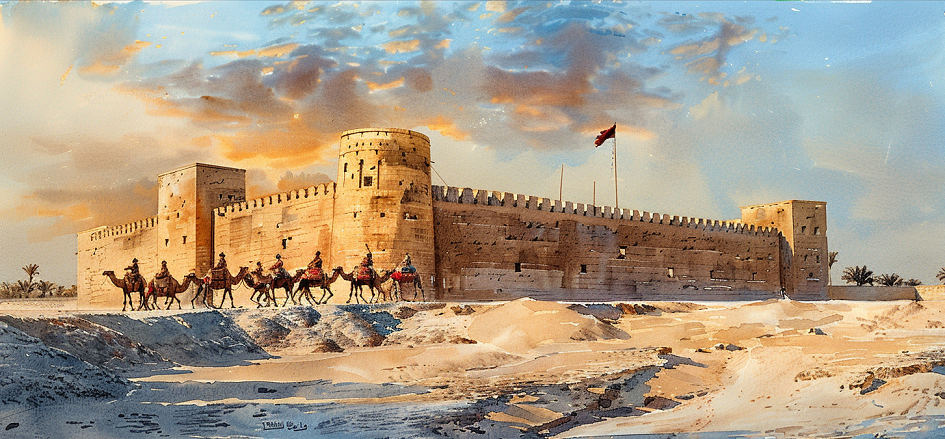Nestled in the heart of the Persian Gulf, the Kingdom of Bahrain stands as a testament to the rich tapestry of human civilization and its unyielding spirit of commerce and cultural exchange. This small island nation, once known as Dilmun in ancient texts, served as a pivotal junction in the complex web of trade routes that crisscrossed the ancient world. Bridging the lands of Mesopotamia, the Indus Valley, and Ancient Egypt, Bahrain’s strategic geographical position and its abundant natural resources, including the famed freshwater springs and lustrous pearls, made it a linchpin in the maritime trade networks that flourished thousands of years ago. The essay that follows delves into Bahrain’s historical background, highlighting its role as a crossroads of civilizations and its significant impact on ancient trade routes. By exploring the remnants of the Dilmun Civilization, examining archaeological findings, and discussing the island’s influence on cultural and economic developments, we uncover the layers of history that define Bahrain’s legacy in the annals of human history. Names of places like the Bahrain Fort, the Barbar Temple, and terms such as “Dilmun” will feature prominently, along with the tribes and peoples who interacted with and contributed to Bahrain’s rich historical narrative.
Historical Background
The history of Bahrain is a mosaic of various cultures, peoples, and epochs, each adding its unique hue to the island’s vibrant past. Archaeological excavations on the island have unearthed evidence of human settlement that dates back to the 5th millennium BCE, revealing Bahrain’s long-standing role as a hub of trade and cultural exchange.
Early History of Bahrain
The discovery of ancient burial mounds across Bahrain provides a silent testament to the island’s early significance. These burial mounds, numbering in the thousands, are among the most visible indicators of a sophisticated society that thrived in the region over 4,000 years ago. The scale and complexity of these burial sites suggest a society that was not only wealthy but deeply entrenched in ritualistic practices, pointing to Bahrain’s early emergence as a centre of trade and spiritual significance.
The Dilmun Civilization
Bahrain’s identification with the ancient Dilmun Civilization brings to light its historical prominence as a trading hub. The Dilmun Civilization, flourishing around 2000 BCE, is often referenced in Sumerian texts as a paradisiacal land, rich with life and a place where sickness and death were unknown. This mythical portrayal underscores Bahrain’s importance in the ancient world, not just as a centre of material wealth but as a spiritual and cultural beacon. The island’s abundant freshwater springs, mentioned in these texts, made it a unique and vital oasis in the harsh landscapes of the Gulf, attracting traders and settlers from across the ancient world.
References to Bahrain in Ancient Texts and Historical Records
The mention of Bahrain, under its ancient name ‘Tylos’, by the Greek geographer Ptolemy, further illustrates its significance in antiquity. Ptolemy’s reference highlights Bahrain’s role in the broader narrative of ancient geography and trade, positioning it as a crucial node in the network of maritime routes that linked the East and West. This historical acknowledgment not only underlines Bahrain’s strategic geographical location but also its integration into the consciousness of the ancient world as a place of wealth, culture, and cross-cultural interaction.
This exploration into Bahrain’s historical background sets the stage for a deeper understanding of its pivotal role in the tapestry of ancient civilizations. Through the lens of its early history, the Dilmun Civilization, and its recognition in historical records, we begin to appreciate the island’s enduring legacy as a crossroads of cultures and commerce.
Geographical Significance
The geographical significance of Bahrain cannot be overstated when considering its role in ancient trade networks. Positioned in the Persian Gulf, close to the shores of the Arabian Peninsula, Bahrain served as a vital maritime link between the great civilizations of Mesopotamia, the Indus Valley, and Ancient Egypt. This strategic location facilitated not only the exchange of goods but also the flow of ideas, technologies, and cultural practices among these ancient societies.
Bahrain’s Location in the Persian Gulf
The island’s placement in the Persian Gulf provided a unique advantage, acting as a natural waypoint for ships navigating the complex waters between the Mesopotamian river valleys and the Indus Valley. By connecting these distant lands, Bahrain became an essential stopover for traders and explorers, making it a melting pot of cultures and a centre for trade. The Persian Gulf’s waters, teeming with maritime routes, underscored Bahrain’s role as a guardian of these ancient highways, ensuring the island’s prosperity and strategic importance throughout antiquity.
Natural Resources: Freshwater Springs and Pearls
Among Bahrain’s most prized natural resources were its freshwater springs, which were not only vital for the sustenance of its inhabitants but also a rare commodity in the arid landscapes of the Gulf. These springs are believed to have played a significant role in the mythological and real significance of Dilmun as a paradise land. Equally important to Bahrain’s economic prosperity was its pearl fishing industry. The island’s waters were renowned for yielding pearls of exceptional quality, making them highly sought after by civilizations from Rome to India. The trade in pearls not only brought wealth to Bahrain but also contributed to its cultural and economic interactions with distant lands, cementing its status as a trade hub.

Bahrain’s Role in Ancient Trade Routes
Bahrain’s strategic geographical location and its wealth of natural resources catapulted it into the center of ancient trade routes, serving as a crucial nexus for commerce and cultural exchange between East and West. This section delves into the multifaceted role Bahrain played in ancient maritime and overland trade networks, highlighting its contributions to the economic and cultural dynamism of the ancient world.
Maritime Trade Routes Connecting the Indus Valley and Mesopotamia
Bahrain’s position in the Persian Gulf placed it squarely on the maritime routes that facilitated trade between the civilizations of the Indus Valley and Mesopotamia. Artifacts found in Bahrain, such as seals and pottery, bear testimony to the island’s extensive trade relations with these regions. For instance, seals characteristic of the Indus Valley civilization have been unearthed in Bahrain, indicating a direct trade link that allowed for the exchange of goods, ideas, and technologies. This not only underscores Bahrain’s importance in ancient trade but also its role in the broader prehistoric globalization processes.
Trade of Goods: Pearls, Spices, Textiles, and Precious Metals
The array of goods traded through Bahrain was diverse, ranging from local pearls to imported spices, textiles, and metals. Bahrain’s pearls, known for their luster and quality, were especially valued in markets as far-flung as Rome, where they adorned the nobility. Similarly, Bahrain served as a redistribution center for spices and textiles from India and precious metals like gold and silver from Mesopotamia and beyond. This trade in high-value goods not only enriched the local economy but also facilitated cultural exchanges, as these goods often carried with them elements of their originating cultures.

Strategic Importance in the Control and Security of Sea Lanes
Beyond its role as a trading post, Bahrain was pivotal in maintaining the security and control of the maritime trade routes that passed through the Persian Gulf. The island’s strategic location enabled it to monitor and protect the sea lanes from piracy and conflict, ensuring safe passage for merchants and traders. This guardianship of the trade routes further enhanced Bahrain’s economic standing and its importance to the prosperity of the region’s ancient civilizations.
Cultural and Economic Impact
The profound impact of Bahrain’s strategic role in ancient trade routes extended well beyond mere economic prosperity. It fostered a unique cultural synthesis and influenced the social fabric of the island, shaping its development in significant ways. This section explores the cultural and economic ramifications of Bahrain’s involvement in ancient trade networks.
Influence on Bahrain’s Cultural Development
Trade brought more than goods to Bahrain; it ushered in a wave of cultural influences that enriched the island’s social and religious life. The influx of traders and settlers from various parts of the ancient world introduced new religious practices, languages, and artistic traditions, creating a cosmopolitan society. For instance, the worship of Mesopotamian deities alongside local gods reflects the syncretic religious practices that emerged. Additionally, the presence of Indus Valley script on seals and artifacts found in Bahrain suggests linguistic exchanges that accompanied trade relations. This blend of cultural elements gave rise to a distinctive Bahraini identity, rooted in diversity and openness to external influences.
Economic Prosperity and Its Effects on Society and Architecture
The wealth generated through trade had a transformative effect on Bahraini society and its architectural landscape. Economic prosperity led to the development of sophisticated urban centers, with the Bahrain Fort (Qal’at al-Bahrain) serving as a prime example of the island’s architectural achievements. The fort, along with other archaeological sites, reveals the existence of advanced infrastructure, including grand residences and public buildings, indicative of a highly organized and prosperous society. This economic boom also facilitated social stratification, with a wealthy merchant class emerging alongside artisans and traders, further diversifying Bahrain’s social structure.
Role in Facilitating Cultural Exchange Between Civilizations
Bahrain’s strategic position as a trade hub facilitated not just the exchange of goods but also the intermingling of cultures, ideas, and technologies between the East and West. The island acted as a conduit for the spread of technological innovations, such as shipbuilding techniques and navigation methods, which were crucial for the development of ancient maritime trade. Moreover, Bahrain’s role in the spice trade introduced new flavors to the cuisines of distant lands, exemplifying the subtle ways in which trade can influence daily life and cultural practices across regions.
Archaeological Evidence
The significance of Bahrain in ancient trade and its role as a cultural crossroads is further corroborated by extensive archaeological findings. These discoveries provide tangible evidence of Bahrain’s connections with other civilizations and its prosperity as a trade hub. This section highlights key archaeological sites and findings that illustrate the island’s rich historical tapestry.
Key Archaeological Sites in Bahrain
Among the most prominent archaeological sites that attest to Bahrain’s historical importance is the Qal’at al-Bahrain, also known as the Bahrain Fort. This UNESCO World Heritage site was once the capital of the Dilmun civilization and later served various roles through successive cultural phases including Hellenistic, Portuguese, and Islamic periods. Excavations at this site have unearthed urban structures, temples, and artifacts that testify to the island’s vibrant trade and cultural exchanges over millennia.

Another significant site is the Barbar Temple, which is linked to the Dilmun civilization. The temple complex, dedicated to the god Enki and his wife Ninhursag, offers insights into the religious practices and architectural advancements of the time. The presence of a fresh water spring near the temple underscores the importance of water in Dilmun’s mythology and its real-life scarcity in the region.
Findings from These Sites That Illustrate Bahrain’s Trade Connections
Archaeological excavations have revealed a wealth of artifacts that highlight Bahrain’s trade connections. Items such as seals from the Indus Valley, Mesopotamian cylindrical seals, pottery from Persia, and even remnants of materials from the Roman Empire have been found, indicating a vast network of trade. The variety and origin of these artifacts not only demonstrate Bahrain’s central role in ancient trade but also its capacity to integrate diverse cultural influences.
Moreover, the discovery of large quantities of fish bones and pearls at these sites provides evidence of the island’s economic activities and its renowned pearl diving industry. The pearls, often referred to as “tears of the gods,” were a major export and coveted luxury in ancient markets, further attesting to Bahrain’s economic prosperity.
Bahrain’s historical narrative, as unearthed through archaeological discoveries and chronicled in ancient texts, reveals its pivotal role at the crossroads of civilizations. Its strategic geographical location, coupled with a wealth of natural resources, positioned Bahrain as a linchpin in the ancient trade routes, facilitating economic prosperity and cultural exchanges between the East and West. The archaeological sites and artifacts bear testament to a vibrant society that engaged in extensive trade networks, integrating diverse cultural influences and fostering a unique identity that thrived on openness and interaction.

The legacy of Bahrain as a hub of ancient trade and cultural exchange continues to resonate, offering insights into the interconnectedness of human societies and the enduring impact of trade on cultural development. As we reflect on Bahrain’s rich historical tapestry, it becomes evident that the island was more than just a centre of commerce; it was a crucible of cultural fusion, innovation, and human achievement. This essay has attempted to illuminate Bahrain’s strategic role in ancient trade routes, underscoring its significance in the broader narrative of human history and its contribution to the cultural and economic dynamism of the ancient world.

